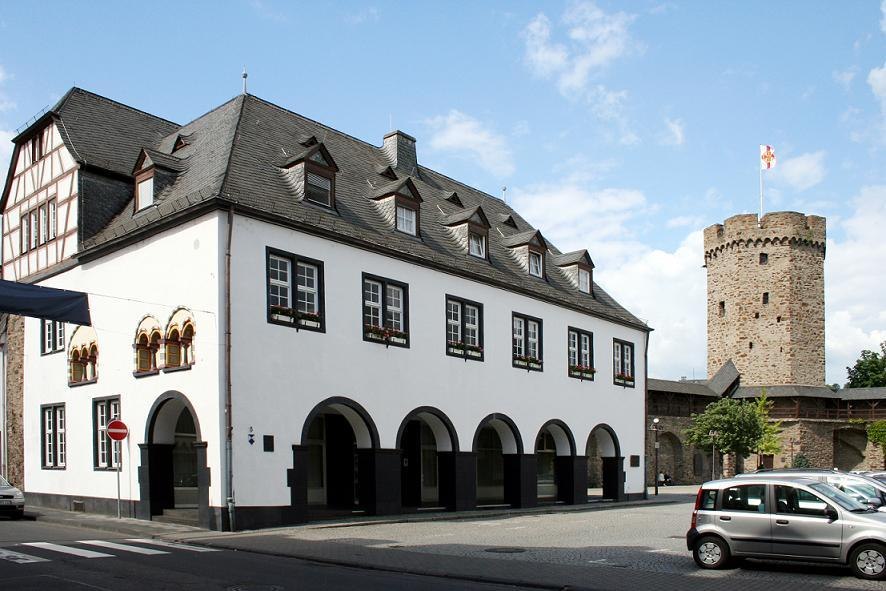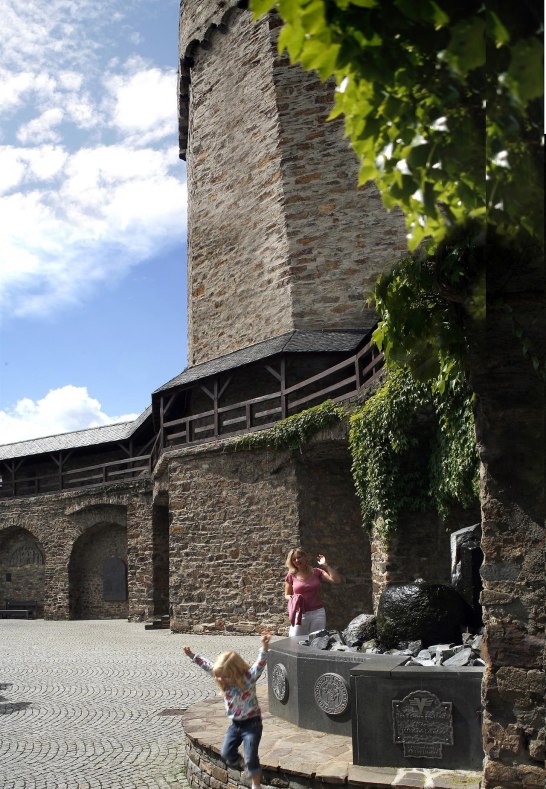00:00 - 23:59
Salhofplatz Square
Salhofplatz, 56112 Lahnstein
The Franconian royal court Salhof was first mentioned in documents in the year 977. The oldest parts of the current building date from 1150 to 1170. In 1686, Salhof was baroque redesigned and expanded by Johann Freiherr vom und zum Stein.
Today, the building, renovated in 1969, serves as a reception hall and houses rooms of the city administration; among other things, the tourist information is located there.
Inserted into the city wall is the tympanum relief, a limestone relief from the 12th century. On the coin fountain with the coat of arms of the city of Lahnstein, various Roman coins and Lahnstein gold ducats are attached.
Seed and Lifeline
This is a place for ruling and representing. In the early Middle Ages, when the Franks took possession of the region along the Middle Rhine, they chose this conveniently located site near the mouth of the Lahn to establish an aristocratic residence.
The Salhof forms the center of the local Frankish lordship. The estate is home to the steward of the ruler. He commands the Salland, the extensive lands owned by the king. His servants and maidens, day laborers, and farmers obligated to labor for him perform the fieldwork. Therefore, the Salhof also includes stables and barns, storage buildings for the harvest and taxes, as well as the accommodations for his staff. Court is held before the aristocratic building.
Around the year 900, the Salhof and the associated land south of the mouth of the Lahn come into the possession of the Archbishopric of Mainz. The Archbishops and Electors of Mainz continuously expand their power position at the northwestern border of their empire. The Salhof is also rebuilt and expanded. This is evidenced by the oldest preserved parts of the building, the Romanesque window arches on the west side, dating from the years 1150-1170.
With the granting of city rights by King Ludwig the Bavarian in 1324, Oberlahnstein gains the right to build a city fortification. Just a few years later, the city is surrounded by a powerful wall 1280 meters long, with bastions, forewalls, and a surrounding moat.
In addition to the Martinsburg serving as a corner bastion, 16 watchtowers secure the site. Six of them are gate towers. The northeastern corner of the city fortification is formed by the Witch Tower.
In the immediate vicinity of the Salhof, a dungeon is established on the ground floor. During the witch hunts of the 16th century, suspected women are held captive there. The Salhof, the Witch Tower, and the section of the city wall at the end of the square survive the destruction in the devastating wars of the 17th century. Johann Freiherr vom und zum Stein, an ancestor of the famous Prussian diplomat, acquires the former royal court and has it renovated and expanded in the contemporary Baroque style.
In the 19th century, the Municipal Market Hall moves into the dominant building. For the growing number of tourists and business travelers, a luxurious hotel is built on the opposite side of the square in the early 20th century, the Kaiserhof.
Today, the historical Salhof houses the Tourist Information of the city of Lahnstein, while the large hall serves as a reception area for the administration. The Witch Tower, one of the six remaining watchtowers of the city fortifications, has housed parts of the Lahnstein City Museum since 1965. The former guard room of the tower crew on the second floor is used for weddings and other festive occasions. The largest preserved section of the city wall with a reconstructed walkway is located at Salhofplatz.
In an arch of the city wall, a tympanum is embedded, a limestone relief from the 12th century, which was originally created as a door arch filling for the Romanesque St. Martin's Church. Another wall niche is adorned by the coin fountain with the city crest, coins minted in Lahnstein in the 14th century, and coins found in a Roman coin hoard.
The town hall from 1973 is the event center of the city. The lower ornamental facade as well as the wall, floor, and ceiling designs inside the building come from the highly awarded artist Otto Herbert Hajek. Despite its recent date, the town hall is already listed as a monument due to its outstanding design.
A memorial in this historically significant square commemorates the terrible fate of the Jewish residents of Lahnstein during the violent regime of the National Socialists.




